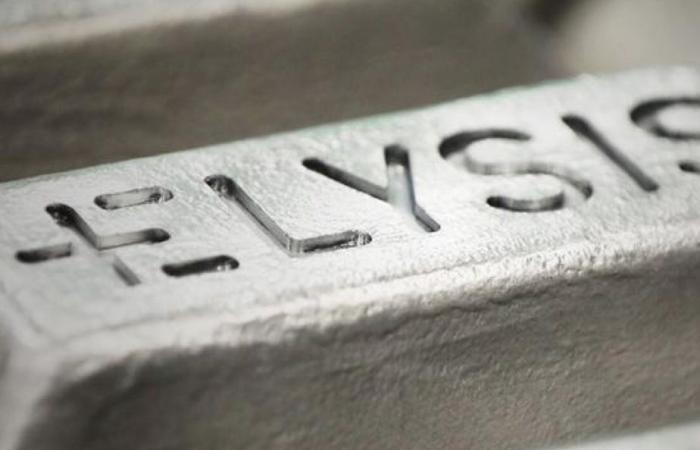It’s not yet on an industrial scale, but Rio Tinto is taking another step in the production of 100% green aluminum with a new “demonstration” plant. Quebec and Ottawa are loosening the purse strings to allow this $375 million project to see the light of day.
Published at 10:00 a.m.
The multinational will deploy Elysis technology in a building that will be erected on the site of its Arvida factory, in Saguenay–Lac-Saint-Jean. Start-up is planned for 2027. At around 2,500 tonnes per year, production will be modest. For example, the AP60 aluminum smelter, announced last year by Rio Tinto, is counting on an annual production of 160,000 tonnes of gray metal.
“We have a fairly cautious approach,” says Rio Tinto Aluminium’s senior director of Atlantic operations, Sébastien Ross, in a telephone interview. “Given that this is a disruptive technology, there are a lot of things that have to be developed from scratch.”
In development in Saguenay since 2018, Elysis is considered very promising, but it is still in its infancy. Rio Tinto, Alcoa and Apple financed part of the project. The Legault government has already injected 80 million into the adventure, compared to 60 million for the federal government.
The Quebec aluminum industry is less polluting than elsewhere in the world thanks to hydroelectricity, but its manufacturing process makes this sector the main industrial emitter of greenhouse gases (GHG) in Quebec. Elysis manages to produce gray metal without any GHG, but on a very small scale in a controlled environment.
To move to the next stage, Rio Tinto and Investissement Québec (IQ) are setting up a limited partnership to use the Elysis licence. The Australian-British mining giant is putting $235 million on the table, while the financial arm of the Quebec government is injecting $140 million.
Ottawa is also offering several tens of millions of dollars, but at the time of writing, it was not possible to know the amount. Rio Tinto would not say whether the money from the Trudeau government will reduce the amount it is spending to build the green aluminum demonstration plant.
These details were revealed Friday in Saguenay, as part of an event bringing together Mr. Ross, the federal Minister of Innovation, Science and Industry, François-Philippe Champagne, the Quebec Minister of the Economy , Innovation and Energy, Pierre Fitzgibbon, as well as his colleague in Municipal Affairs, Andrée Laforest.
This investment by Rio Tinto is in addition to that of 1.4 billion announced last year in Saguenay for the construction of 96 AP60 technology tanks, which represents the production of approximately 160,000 metric tons of primary aluminum. This project, which benefits from a subsidy loan of 150 million from the Legault government, will reduce GHG emissions by 50% compared to the old tanks of the Arvida factory.
First step
The ten tanks that will be installed in the Elysis demonstration plant in Arvida will be four times smaller than the usual format. Mr. Ross assures that there is a demand for 100% green aluminum – companies like Apple and the brewing giant AB InBev are among the customers – but that there are still “learnings” to be done with this new technology.
“It’s the raw materials used in the process that are different and are quite rare on the planet,” he says. “I would go so far as to say that. It’s a major technological issue. The biggest mistake we could make is to skip steps and make a mistake that would be fatal and that would have the potential to kill the technology.”
For the moment, it is impossible, according to the manager of Rio Tinto, to know when we will be able to industrialize this process. The risk level must be lowered further, he says. Thinking about profits at this stage is a bit “utopian”.
Nevertheless, Mr. Fitzgibbon believes that the financial risk for the Quebec state is moderate in this project. The agreement with Rio Tinto provides that the multinational will ultimately purchase Quebec’s stake in the limited partnership, if everything goes as planned.
“We negotiated [une mécanique] where the buyback will be equal to the cost of funds and we have an interesting potential return that we can also make, says the Quebec Minister of the Economy. Whether we achieve a return of 4% or 7% on the investment is secondary compared to the comparative advantage that Quebec will have if we are the first to produce green aluminum.
Could the Quebec government possibly be called upon to inject more money into the limited partnership to avoid dilution if other investments are necessary? Perhaps, Mr. Fitzgibbon concedes, adding that Rio Tinto will have to be able to complete the project.
“At some point, it’s no longer up to the government to support this,” he says.
According to Rio Tinto, demolition and preparation work will begin “now” and construction of the new factory should begin “in early 2025”.
Learn more
-
- 37 %
- Quebec’s participation in the limited partnership that will operate the Elysis demonstration plant in Arvida
the press
- 220 millions
- Amount increased by the Quebec government in the 100% green aluminum project since 2018
the press







